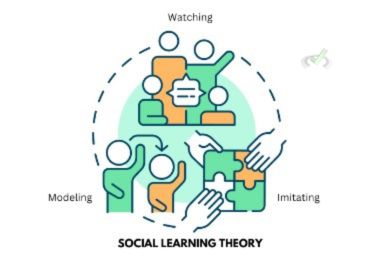Have you ever learned something just by watching someone else? This is called observational learning. It's a way we learn by watching and copying others instead of learning from direct experience. Let's explore what observational learning is and why it's important.
I. Understanding Observational Learning
Observational learning is when we learn new behaviors or skills by watching others. It's also known as social learning. There are four main steps: attention, retention, reproduction, and motivation.

Attention
To learn through observation, you need to focus on the person doing the behavior. If you're distracted or uninterested, you won't learn either.
For example, if you're watching a cooking show, paying close attention to the chef's methods is key. Factors like how much you like or respect the person or how interested you are can affect your attention.
Retention
Once you've paid attention, the next step is to remember what you saw. Retention means keeping the information in your memory.
For example, after watching the cooking show, you should be able to recall the steps when you try to cook the dish later. Remembering well depends on how often you think about or use the information.
Reproduction
Reproduction means doing the behavior you saw. This step involves practicing and turning what you see into actions.
It includes physical skills, like using a knife, and mental skills, like following steps. The more you practice, the better you get.
Motivation
Motivation is the desire to copy the behavior. Different things can influence your motivation, like rewards or seeing others benefit.
For example, you might be more motivated to cook if you know your family will enjoy the meal. Motivation can come from inside (personal satisfaction) or outside (praise or rewards).
II. Factors That Influence Observational Learning
Several factors can make observational learning more or less effective.
The Model's Characteristics
The person you're watching, called the "model," is important. You'll learn better if the model is someone you look up to or find similar to yourself. For instance, children often imitate their parents or older siblings because they admire them.
The Behavior's Consequences
If you see the model rewarded for their behavior, you're more likely to copy it. This is called vicarious reinforcement.
For example, if you see a friend being praised for being kind, you might want to be kind too. Seeing the results of actions can influence your own choices.
The Observers’ Abilities
Your skills and confidence affect your ability to do the behavior you observed. You're more likely to try if you believe you can do it.
If you don't feel confident or think it's too hard, you might not try. For example, a beginner cook might avoid trying a difficult recipe they saw on TV because they don't feel ready.
III. Theories of Observational Learning
Several theories explain why observational learning works.
Social Learning Theory
Albert Bandura, a famous psychologist, developed the Social Learning Theory. This theory emphasizes the importance of watching, modeling, and imitating behaviors.
According to Bandura, our environment, behavior, and personal factors all work together to influence learning. For example, Bandura's Bobo doll experiment showed that children copied aggressive behavior after watching adults act aggressively and be rewarded for it. This shows that people can learn behaviors just by watching others.

Mirror Neurons
Researchers have found special brain cells called mirror neurons. These neurons activate when we do an action and when we see someone else do the same action.
For instance, when you see someone smile, your mirror neurons activate, making smiling easier too. This helps explain why watching someone can teach us how to behave. However, the exact role of mirror neurons is still being studied, and there's a lot to learn about how they work.

IV. Applications of Observational Learning
Understanding observational learning has many real-world uses
Education
Teachers can use observational learning to show positive behaviors and skills. For example, demonstrating how to solve a math problem step-by-step can help students learn how to do it. By watching the teacher, students can better understand and apply the process themselves.
Parenting
Parents can set examples for their children by showing the behaviors they want to see. For instance, showing kindness and patience can encourage kids to be the same. Children often copy their parents, so good modeling is very important.
Therapy
Therapists use observational learning to help clients learn new skills or change behaviors. For example, role-playing in therapy can allow clients to watch and practice proper social interactions. This can be very helpful for building confidence and social skills.
V. Bridge/Overlap
Observational learning connects to other areas both in psychology and beyond.
Social Influence
Observational learning is related to social influence. Both involve changing behaviors by seeing others. Understanding both can help explain how people adapt to social norms and why they conform or follow authority.
Motivation and Rewards
Motivation and reinforcement are important in both observational learning and operant conditioning. Operant conditioning is when behaviors are learned through rewards and punishments.
In both cases, motivation can come from within or from outside rewards. It affects how likely a person is to adopt a behavior.
Cognitive Development
Observational learning plays a role in cognitive development, especially in children. As they watch adults, they learn new words, behaviors, and skills.
It helps with overall development. Psychologists' theories explain how children learn by watching and interacting with their world.
Cultural Transmission
Observational learning is key for passing down cultural practices, traditions, and norms. By watching others, people learn what's acceptable and valued in society. For example, children learn cultural traditions and social norms by watching family members and community leaders.
VI. Wrap Up/Key Terms
Let's summarize the key points:
- Observational Learning: Learning by watching and imitating others.
- Attention: Focusing on the behavior being observed.
- Retention: Remembering the observed behavior.
- Reproduction: Performing the behavior.
- Motivation: Willingness to perform the behavior.
- Vicarious Reinforcement: Learning by seeing the model rewarded.
- Social Learning Theory: Bandura's theory emphasizes the role of observation and imitation.
- Mirror Neurons: Brain cells that activate both during performance and observation of an action.
VII. Practice
Test your understanding with these questions:
Sample Practice Question 1
What is observational learning?
A. Learning by making mistakes.
B. Learning through direct experience.
C. Learning by watching and imitating others.
D. None of the above.
Ans. C
Observational learning involves learning new behaviors or skills by watching others perform them.
Sample Practice Question 2
What is vicarious reinforcement?
A. Learning from direct experience.
B. Learning by seeing the model being rewarded.
C. Learning through trial and error.
D. Learning by following strict instructions.
Ans. B
Vicarious reinforcement occurs when an individual is motivated to imitate a behavior because they observed someone else being rewarded for it.







 To help you achieve your goal MCAT score, we take turns hosting these
To help you achieve your goal MCAT score, we take turns hosting these 





















 reviews on TrustPilot
reviews on TrustPilot